Five New Species of Aureoboletus and Chalciporus (Boletaceae, Boletales) and Their Ethnomycological Aspects
Abstract
:1. Introduction
2. Materials and Methods
2.1. Sampling and Morphological Characterization
2.2. DNA Extraction, Amplification, Sequencing, and Phylogenetic Analysis
3. Results
Phylogenetic Analyses
| 1a. Smooth basidiospores ……………………………………………………………………………………………………………………………………………………………………………. 4 |
| 1b. Ornamented basidiospores………………………………………………………………………………………………………………………………………………………………………. 2 |
| 2a. Alveolate to reticulate, ellipsoid, subfusiform basidiospores ………………………………………………………………………………………………………………………………. 3 |
| 2b. Ellipsoid, longitudinally winged basidiospores with pale brown or pale yellow color, and smooth, glutinous, fibrillose stipe………………………………………….. A. singeri |
| 3a. Reddish, alveolate-to-reticulate stipe that is longitudinally striate, with complete, short, and thick and conspicuous, ellipsoid, cylindrical basidiospores ……….. A. russellii |
| 3b. Whitish, yellow to orange alveolate to reticulate stipe; basidiospores are superficially and discontinuously reticulate, and ellipsoid to fusiform in shape …………. A. betula |
| 4a. Yellow, orange-yellow, brown-orange, pale brown, cinnamon, red, reddish-brown, and red-cinnamon basidiomata ……………………………………………………………… 6 |
| 4b. Basidiomata with other colors …………………………………………………………………………………………………………………………………………………………………... 5 |
| 5a. Salmon to peach-colored pileus; salmon hymenophore; pores are salmon, circular, angular to irregular at the edges; concolorous to the hymenophore stipe, with mame-lonate to umbonate pileus, small triangular scales, and crenulate margin …………………………………………………………………………………………………………… A. elvirae |
| 5b. Vivid blue, violet blue, to light blue pileus; bright yellow hymenophore, and the context is whitish bruising pink to pale red when young, and yellow when mature; 9– 14 × 4–5(–6) µm basidiospores ………………………………………………………………………………………………………………………………………………………………… A. garciae |
| 6a. Brown-orange, pale brown, cinnamon, red, reddish-brown, red-cinnamon pileus ……………………………………………………………………………………………………… 7 |
| 6b. Vivid yellow, orange-yellow, or orange-brown pileus; golden hymenophore even in dried specimens; and 9–10 (13) × 3– 4 (5) µm, smooth, ellipsoid to subfusiform basidiospores ………………………………………………………………………………………………………………………………………………………………………… A. auriflammeus |
| 7a. Surface of pileus is viscid, innately fibrillose to reticulate …………………………………………………………………………………………………………………………………... 8 |
| 7b. Surface of pileus is dry, tomentose to areolate at maturity ………………………………………………………………………………………………………………………………….. 9 |
| 8a. Surface of stipe is reticulate at apex or costate ………………………………………………………………………………………………………………………………………………. 10 |
| 8b. Surface of stipe ranges from very viscid to furfuraceous to smooth, is white without color change upon cutting the context, and has (10–)11–13 (–14) × (3.5–) 4–5µm basidiospores ………………………………………………………………………………………………………………………………………………………………………………….. A. readii |
| 9a. With 12–15(–18) × 5–6 µm basidiospores, the surface of hymenophore is reticulate at apex from the tube remnants, and changes from white bruising brown to brown-orange upon cutting the context ……………………………………………………………………………………………………………………………………………………….. A. flaviporus |
| 9b. With basidiospores that are 11–16 × 4–6 µm, stipe is costate or reticulate from decurrent tubes, with yellow floccose, and is pale pinkish-brown downward; the hymenophore has a golden-yellow color when dry; the context is yellowish; and the stipe base is pinkish vinaceous or orange-brownish …………………………… A. auriporus |
| 10a. Basidiomata are medium-sized (>25 mm in diam.), and the surface of the pileus is smooth, tomentose, and dry ………………………………………………………………... 11 |
| 10b. Basidiomata are small-sized (25 mm in diam.); the surface of the pileus is ornamented, micro-scale to areolate; the hymenophore is vivid yellow; and the basidiospores are amyloid …………………………………………………………………………………………………………………………………………………………………………………. A. ayuukii |
| 11a. Basidiospores reaching 26 µm in length, thick-walled, with free margin, and pro-jecting and hanging straight down, with dry, smooth, subtomentose, and not-cracked surface …………………………………………………………………………………………………………………………………………………………………………………… A. projectellus |
| 11b. Basidiospores reaching 17 µm and thin-walle ……………………………………………………………………………………………………………………………………………… 12 |
| 12a. Distributed in mixed forests, the surface of the pileus is smooth and slightly areo-late at maturity; the color ranges from brown, red to red-brown, rarely with greenish tinges, or white to pale yellow; the pileipellis context is vinaceous; yellow basal mycelium, 9–12.5 × 3–5µm basidiospores ……………………………………………….. A. innixus |
| 12b. Distributed in cloud forest, the surface of the pileus is granulose and roughened to nearly glabrous at maturity, and its color ranges from yellow-brown, brown-red, to dull orange; the hymenophore is whitish to pale yellow; the stipe base is bulbose; and basidiospores are 9.5–11(–13) × 3.5–4(–4.5) µm ………………………………….. A. roxanae |
| 1a. Red, brown-reddish, brown-orange, cinnamon to ferruginous basidiomata …….……………………………………………………………………………………………………….. 2 |
| 1b. Yellow, ochraceous-yellow to yellow-brown basidiomata; yellow, gold to yellow-brownish hymenophore; and (7−) 8−10 (−11) × (2.5−)3−3.5 (−4) µm basidiospores ………………………………………………………………………………………………………………………………………………………………………… Chalciporus piedracanteadensis |
| 2a. Pores < 1.5 in diameter, and circular to angular ……………………………………………………………………………………………………………………………………………… 3 |
| 2b. Pores is 1.5 mm in diameter, and cinnamon, ochraceous, or ferrugineus; pileus is 20− 60mm, with slightly viscid to dry surface, context is whitish-yellow to pink; 7.2−10.4 × 2.8−4 µm basidiospores; and the taste is very spacy…………………………………………………………………………………………………………………….. Chalciporus piperatus |
| 3a. Small to medium basidiomata that are 20–45 mm; surface of pileus is dry, slightly velvety when young and becoming finely cracked with age, while the color is red or reddish when young, and becomes yellower with age; pores are 0.5 mm in diameter; basidiospores are 10−14.5 (−16.5) × 3−4.5(−4.8) µm ………………………………………………………………………………………………………………………………………………………………………………….. Chalciporus rubinellus |
| 3b. Small basidiomata that is 20–30 mm; surface of pileus is glabrous, dry, entirely marginal when young, and somewhat irregular at maturity, the diameter is 0.3–0.8 mm, the shape is circular to hexagonal, and the color is pale orange, red-brown to cinnamon, unchanging when pores are bruised; basidiospores are 9–11× 3–4 (–5) µm; and this species is distributed in cloud forest……………………………………………………………………………………………………………………………………… Chalciporus perezsilvae |
4. Discussion
5. Conclusions
Author Contributions
Funding
Institutional Review Board Statement
Informed Consent Statement
Data Availability Statement
Acknowledgments
Conflicts of Interest
References
- Wu, G.; Li, Y.C.; Zhu, X.T.; Zhao, K.; Han, L.H.; Cui, Y.Y.; Li, F.; Xu, J.P.; Yang, Z.L. One hundred noteworthy boletes from China. Fungal Divers. 2016, 81, 25–188. [Google Scholar] [CrossRef]
- Wijayawardene, N.N.; Hyde, K.D.; Dai, D.Q.; Sánchez-García, M.; Goto, B.T.; Saxena, R.K.; Erdoğdu, M.; Selçuk, F.; Rajeshkumar, K.C.; Aptroot, A.; et al. Outline of Fungi and fungus-like taxa–2021. Mycosphere 2022, 13, 53–453. [Google Scholar] [CrossRef]
- Hosen, I.; Yang, Z.L. Kaziboletus, a new boletoid genus of Boletaceae associated with Shorea robusta in Bangladesh. Mycol. Prog. 2021, 20, 1145–1156. [Google Scholar] [CrossRef]
- Li, H.; Tian, Y.; Menolli, N., Jr.; Ye, L.; Karunarathna, S.C.; Pérez-Moreno, J.; Mohammad-Mahmudur-Rahman, M.M.; Rashid, M.D.H.; Phengsintham, P.; Rizal, L.; et al. Reviewing the world’s edible mushroom species: A new evidence-based classification system. Compr. Rev. Food Sci. Food Saf. 2021, 20, 1982–2014. [Google Scholar] [CrossRef] [PubMed]
- Steidinger, B.S.; Crowther, T.W.; Liang, J.; Van-Nuland, M.E.; Werner, G.D.A.; Reich, P.B.; Nabuurs, G.J.; de-Miguel, S.; Zhou, M.; Picard, N.; et al. Climatic controls of decomposition drive the global biogeography of forest-tree symbioses. Nature 2019, 569, 404–408. [Google Scholar] [CrossRef] [PubMed]
- Zhang, M.; Li, T.H.; Xu, J.; Song, B. A new violet-brown Aureoboletus (Boletaceae) from Guangdong of China. Mycoscience 2015, 56, 481–485. [Google Scholar] [CrossRef]
- Zhang, M.; Li, T.H.; Nuhn, M.E.; Tserin, T.; Song, B. Aureoboletus quercus-spinosae, a new species from Tibet of China. Mycoscience 2017, 58, 192–196. [Google Scholar] [CrossRef]
- Zhang, M.; Li, T.-H.; Wang, C.-Q.; Zeng, N.-K. Phylogenetic overview of Aureoboletus (Boletaceae, Boletales), with descriptions of six new species from China. MycoKeys 2019, 61, 111–145. [Google Scholar] [CrossRef]
- Murrill, W.A. The Boletaceae of North America. Mycologia 1909, 1, 140–160. [Google Scholar] [CrossRef]
- Haelewaters, D.; Dima, B.; Abdel-Hafiz, B.I.I.; Abdel-Wahab, M.A.; Abul-Ezz, S.R.; Acar, I.; Aguirre-Acosta, E.; Aime, M.C.; Aldemir, S.; Ali, M.; et al. Fungal Systematics and Evolution 6. Sydowia 2020, 72, 271–296. [Google Scholar]
- Farid, A.; Bessette, A.E.; Bessette, A.R.; Bolin, J.A.; Kudzma, L.V.; Franck, A.R.; Garey, J.R. Investigations in the boletes (Boletaceae) of southeastern USA: Four novel species, and three novel combinations. Mycosphere 2021, 12, 1038–1076. [Google Scholar] [CrossRef]
- Singer, R. The Agaricales in Modern Taxonomy, 4th ed.; Koeltz Scientific Books: Koenigstein, Germany, 1986. [Google Scholar]
- García-Jiménez, J.; Garza-Ocañas, F.; de la Fuente, J.I.; Saldivar, A.E.; Ayala-Vásquez, O. Three new records of Aureoboletus Pouzar (Boletaceae, Boletales) from Mexico. Check List 2019, 15, 759–765. [Google Scholar] [CrossRef]
- Ayala-Vasquez, O. Taxonomía, Biogeografía y Filogenia de los Hongos del Orden Boletales en la Sierra Norte de Oaxaca. México. Ph.D. Thesis, Instituto Tecnológico de Ciudad Victoria, Tamaulipas, Mexico, 2021. [Google Scholar]
- Index Fungorum. Available online: http://www.indexfungorum.org (accessed on 8 August 2023).
- Zhang, M.; Li, T.H.; Song, B. Two new species of Chalciporus (Boletaceae) from southern China revealed by morphological characters and molecular data. Phytotaxa 2017, 327, 47–56. [Google Scholar] [CrossRef]
- Winner, M.; Giménez, A.; Schmidt, H.; Sontag, B.; Steffan, B.; Steglich, W. Unusual pulvinic acid dimers from the common fungi Scleroderma citrinum (common earthball) and Chalciporus piperatus (Peppery Bolete). Angew. Chem. 2004, 43, 1883–1886. [Google Scholar] [CrossRef] [PubMed]
- Lodge, D.J.; Ammirati, J.F.; Dell, T.O.; Mueller, G.M. Terrestrial and Lignicolous Macrofungi: Colecting and describing Macrofungi. In Biodiversity of Fungi. Inventory and Monitoring Methods; Mueller, G., Bills, G.F., Foster, M.S., Eds.; Elsevier Academic Press: New York, NY, USA, 2004; pp. 128–158. [Google Scholar]
- Kornerup, A.; Wanscher, J.H. Methuen Handbook of Colours, 3rd ed.; Eyre Methuen: London, UK, 1978. [Google Scholar]
- Martínez-González, C.R.; Ramírez-Mendoza, R.; Jiménez-Ramírez, J.; Gallegos-Vázquez, C.; Luna-Vega, I. Improved method for genomic DNA extraction for Opuntia Mill. (Cactaceae). Plant Meth. 2017, 13, 82–92. [Google Scholar] [CrossRef] [PubMed]
- Hall, T.A. BioEdit: A user-friendly biological sequence alignment editor and analysis program for Windows 95/98/NT. Nucleic Acids Symp. Ser. 1999, 41, 95–98. [Google Scholar]
- Zhang, Z.; Schwartz, S.; Wagner, L.; Miller, W. A greedy algorithm for aligning DNA sequences. J. Comp. Biol. 2000, 7, 203–214. [Google Scholar] [CrossRef]
- Katoh, K.; Misawa, K.; Kuma, K.; Miyata, T. MAFFT: A novel method for rapid multiple sequence alignment based on fast Fourier transform. Nucleic Acids Res. 2002, 30, 3059–3066. [Google Scholar] [CrossRef]
- Katoh, K.; Rozewicki, J.; Yamada, K.D. MAFFT online service: Multiple sequence alignment, interactive sequence choice and visualization. Brief. Bioinf. 2017, 20, 1160–1166. [Google Scholar] [CrossRef]
- Katoh, K.; Standley, D.M. MAFFT multiple sequence alignment software version 7: Improvements in performance and usability. Mol. Biol. Evol. 2013, 30, 772–780. [Google Scholar] [CrossRef]
- Müller, K.D.; Müller, Q.J.; Neinhuis, C. PhyDE®-Phylogenetic Data Editor. Program Distributed by the Authors. Version 10.0. 2005. Available online: https://www.phyde.de (accessed on 6 July 2023).
- Maddison, W.P.; Maddison, D.R. Mesquite: A Modular System for Evolutionary Analysis. Version 3.31. 2017. Available online: http://mesquiteproject.org (accessed on 2 July 2023).
- Stamatakis, A. RAxML version 8: A tool for phylogenetic analysis and post-analysis of large phylogenies. Bioinformatics 2014, 30, 1312–1313. [Google Scholar] [CrossRef] [PubMed]
- Miller, M.A.; Pfeiffer, W.; Schwartz, T. Creating the CIPRES Science Gateway for inference of large phylogenetic trees. In Proceedings of the Gateway Computing Environments Workshop (GCE), New Orleans, LA, USA, 14 November 2010; pp. 1–8. [Google Scholar]
- Huelsenbeck, J.P.; Ronquist, F. MrBayes: Bayesian inference of phylogeny. Bioinformatics 2001, 17, 754–755. [Google Scholar] [CrossRef] [PubMed]
- Frandsen, P.B.; Calcott, B.; Mayer, C.; Lanfear, R. Automatic selection of partitioning schemes for phylogenetic analyses using iterative k-means clustering of site rates. BMC Evol. Biol. 2015, 15, 13. [Google Scholar] [CrossRef]
- Lanfear, R.; Frandsen, P.B.; Wright, A.M.; Senfeld, T.; Calcott, B. PartitionFinder 2: New methods for selecting partitioned models of evolution for molecular and morphological phylogenetic analyses. Mol. Biol. Evol. 2017, 34, 772–773. [Google Scholar] [CrossRef]
- Rambaut, A.; Suchard, M.A.; Xie, D.; Drummond, A.J. Tracer v1.6. 2014. Available online: http://beast.bio.ed.ac.uk/Tracer (accessed on 4 October 2022).
- Zeng, N.K.; Zhang, M.; Lian, Z.Q. A new species and a new combination in the genus Aureoboletus (Boletales, Boletaceae) from southern China. Phytotaxa 2015, 222, 129–137. [Google Scholar] [CrossRef]
- Both, E. New taxa of boletes and two boletes with identity problems. Bull. Buffalo Soc. Nat. Sci. 1998, 36, 215–232. [Google Scholar]
- Klofac, W. The genus Aureoboletus, a world-wide survey. A contribution to a monographic treatment. Osterr. Z. Für Pilzkd. 2010, 19, 133–174. [Google Scholar]
- Xu, C.; Liang, Z.-Q.; Xie, H.-J.; Jiang, S.; Fu, X.-H.; Zeng, N.-K. Two new species of Chalciporus (Boletaceae, Boletales) from tropical China. Mycol. Prog. 2021, 20, 1573–1582. [Google Scholar] [CrossRef]
- Zhang, M.; Li, T.H.; Wang, C.Q.; Song, B.; Xu, J. Aureoboletus formosus, a new bolete species from Hunan Province of China. Mycol. Prog. 2015, 14, 118. [Google Scholar] [CrossRef]
- García-Jiménez, J.; Garza-Ocañas, F. Hongos ectomicorrícicos en el estado de Nuevo León. Rev. Mex. Micol. 1986, 2, 197–205. [Google Scholar]

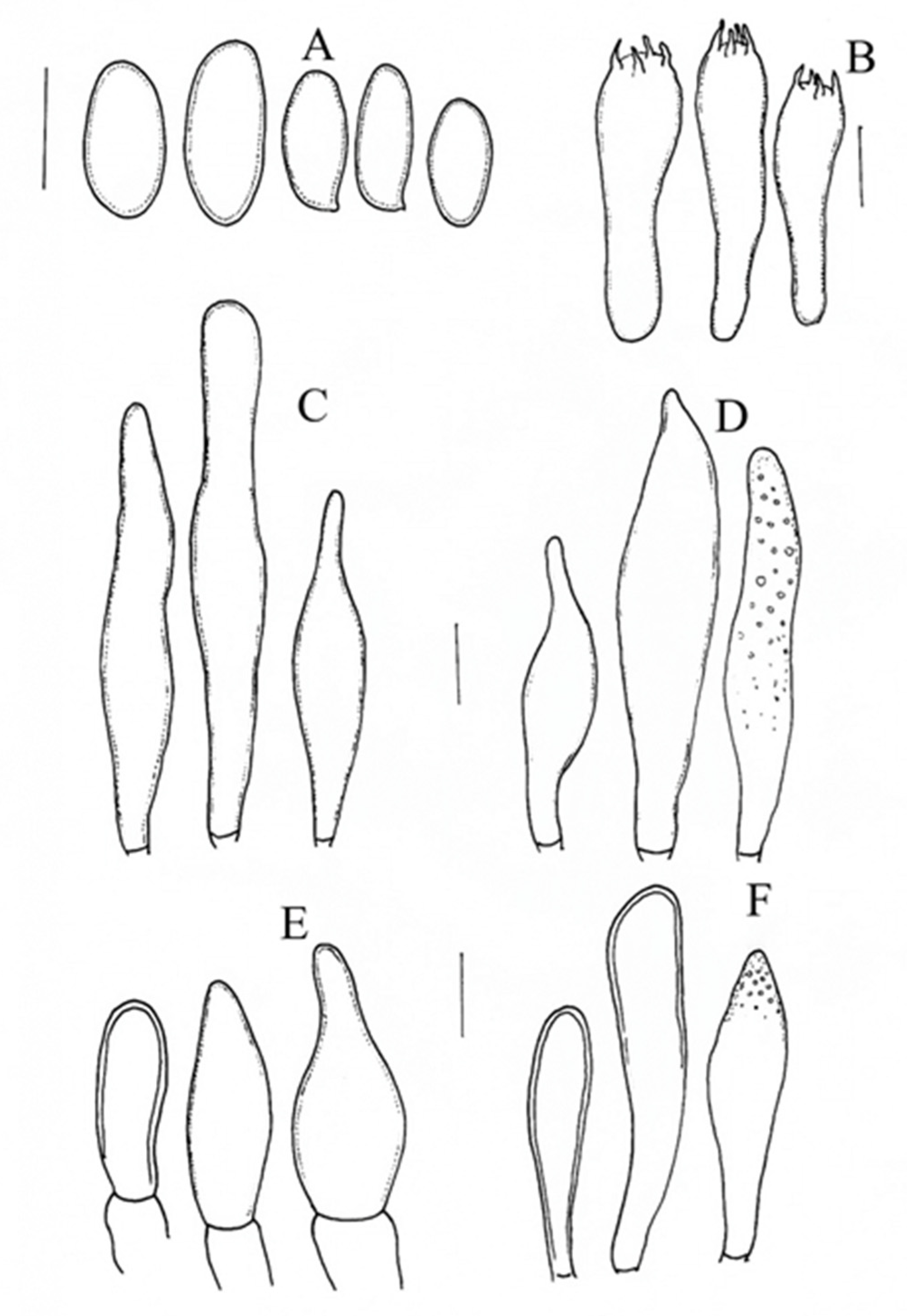
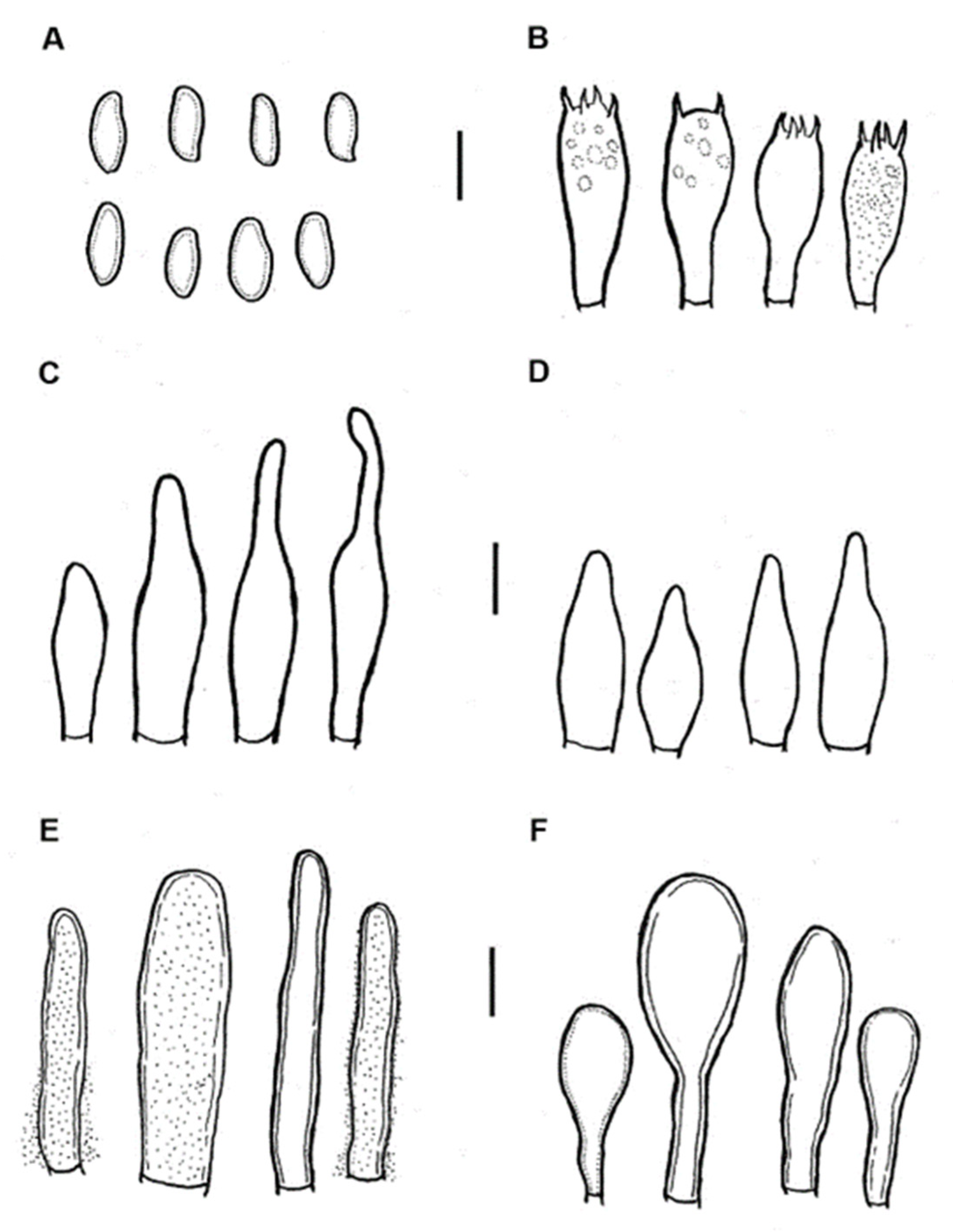
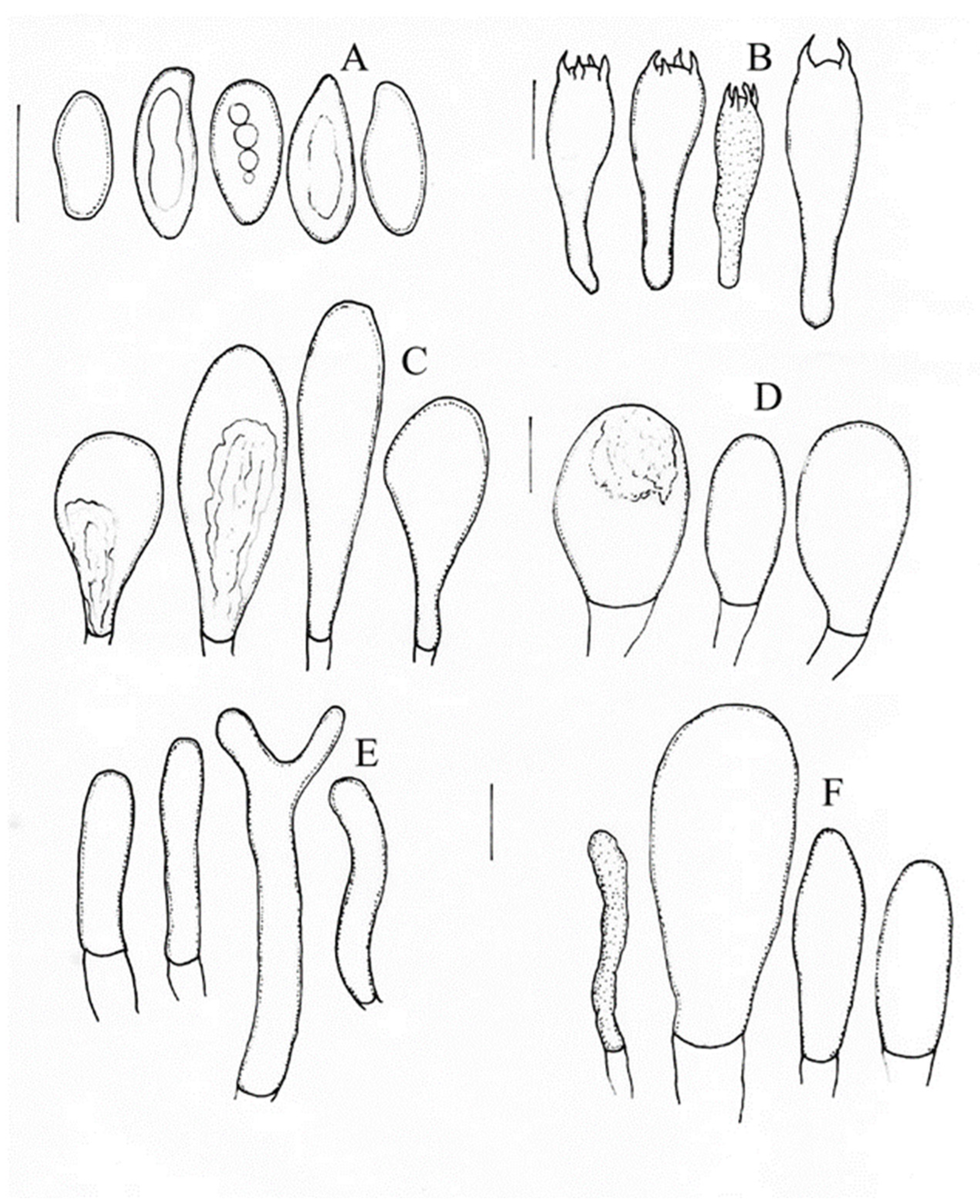
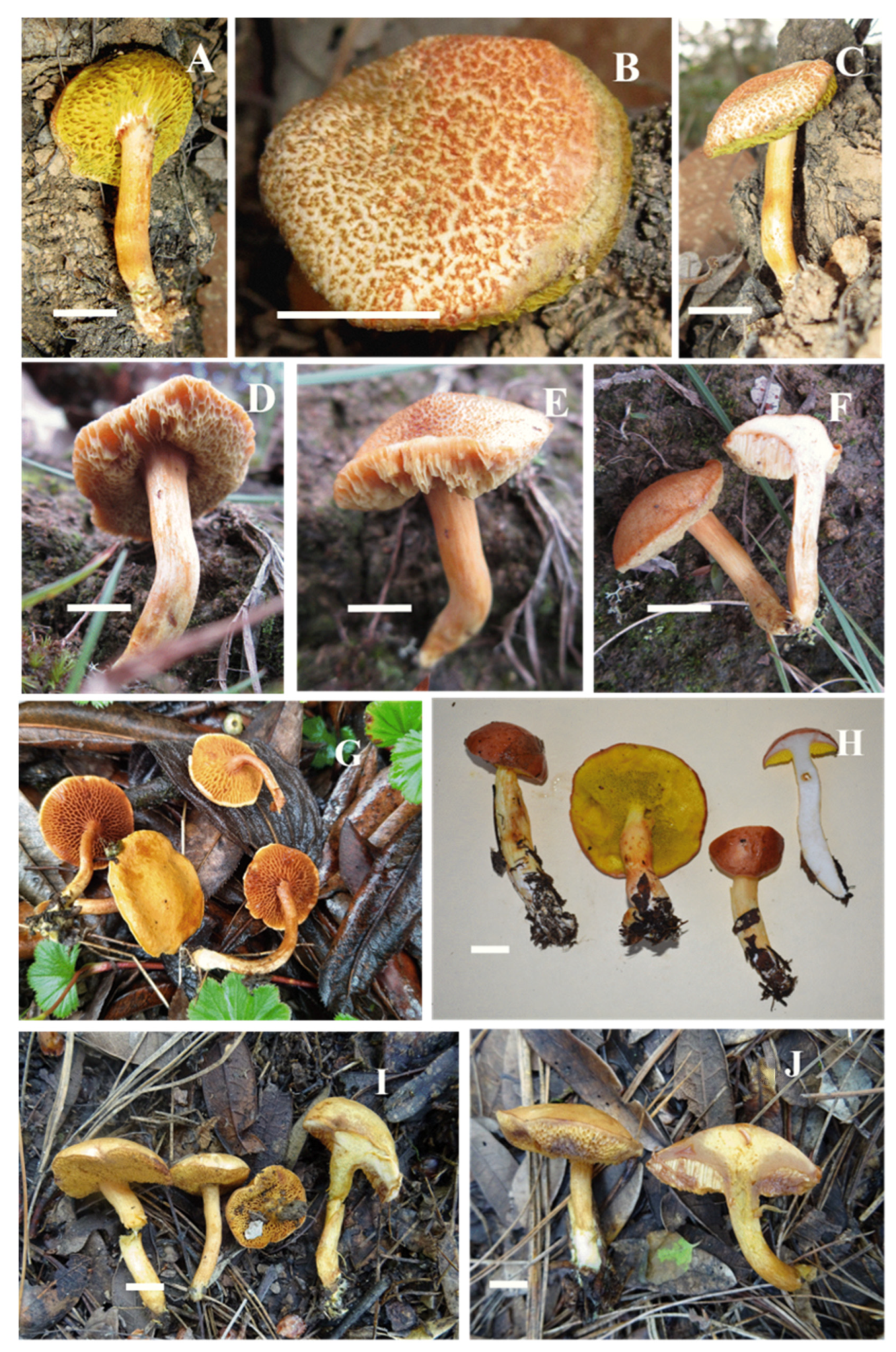


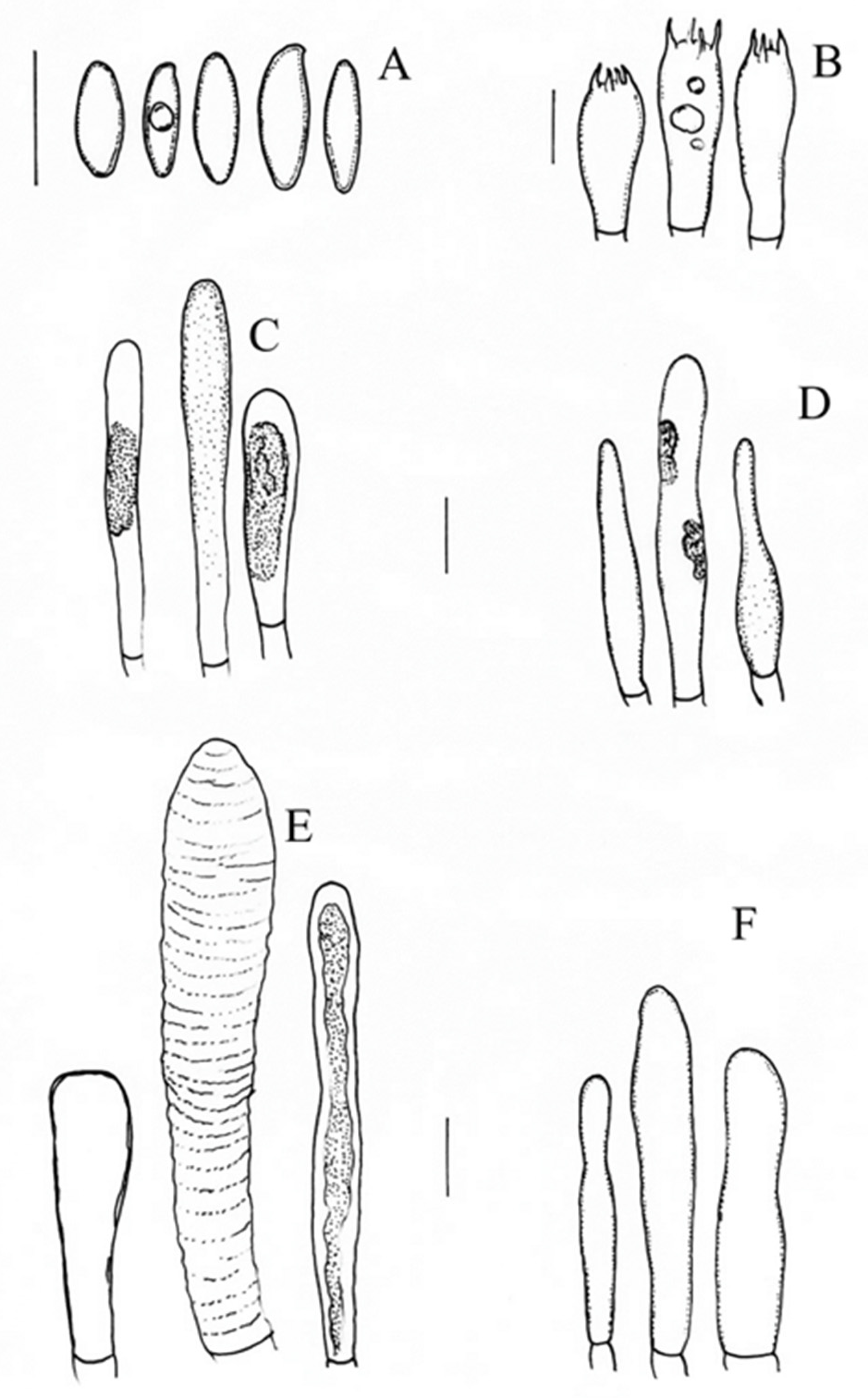
| Fungal Taxa | Specimen Voucher | ITS | LSU | RPB1 | RPB2 | TEF |
|---|---|---|---|---|---|---|
| A. auriflammeus | CFMR BOS 699 | ---------------- | MK601706 | ---------------- | MK766269 | MK721060 |
| A. auriporus | MAN020 | ---------------- | JQ003659 | ---------------- | ---------------- | ---------------- |
| A. auriporus | BDCR0431 | ---------------- | HQ161871 | DQ534636 | ---------------- | ---------------- |
| A. auriporus | strain 35/97 | ---------------- | DQ534636 | ---------------- | ---------------- | ---------------- |
| A. ayuukii | Holotype MEXU 30448 | OR421042 | OR421569 | OR50581 | OR50752 | OR50215 |
| A. catenarius | GDGM45142 | ---------------- | MN204514 | ---------------- | ---------------- | ---------------- |
| A. catenarius | HKAS54463 | ---------------- | KY990509 | KT990890 | KT990348 | KT990710 |
| A. catenarius | HKAS54467 | ---------------- | KT990510 | ---------------- | KT990349 | KT990711 |
| A. clavatus | GDGM42962 | ---------------- | KR052045 | KR052056 | ---------------- | ---------------- |
| A. clavatus | GDGM42963 | ---------------- | KR052046 | KR052057 | ---------------- | KR052054 |
| A. clavatus | GDGM42984 | ---------------- | KR052047 | ---------------- | ---------------- | KR052055 |
| A. clavatus | HKAS59802 | ---------------- | KR052044 | ---------------- | ---------------- | KR052053 |
| A. duplicatoporus | HKAS63009 | ---------------- | KT990511 | KT990891 | KT990350 | KT990712 |
| A. duplicatoporus | HKAS83115 | ---------------- | KT990512 | KT990892 | KT990351 | KT990713 |
| A. duplicatoporus | HKAS50498 | ---------------- | KF112361 | KF112561 | KF112754 | ---------------- |
| A. elvirae | MEXU-HO 30703-ITCV794 | ---------------- | OQ938893 | ---------------- | OQ975746 | ---------------- |
| A. formosus | GDGM44441 | ---------------- | NG057082 | ---------------- | KF291751 | ---------------- |
| A. garciae | Holotype MEXU 29006 | ---------------- | MH337251 | MT228982 | MT228983 | ---------------- |
| A. garciae | MEXU 30133 | ---------------- | MT228976 | MT228981 | MT228984 | ---------------- |
| A. garciae | MEXU 30134 | ---------------- | MT228977 | MT228980 | MT228985 | ---------------- |
| A. garciae | MEXU 30135 | ---------------- | MT228978 | MT228979 | MT228986 | ---------------- |
| A. gentilis | MG372a | ---------------- | KF112344 | KF112557 | KF112741 | KF134014 |
| A. gentilis | Pug1 | ---------------- | DQ534635 | ---------------- | ---------------- | KF030399 |
| A. griseorufescens | GDGM28490 | ---------------- | MH670278 | ---------------- | MH700241 | ---------------- |
| A. griseorufescens | ZM131 | ---------------- | MH670279 | MH700220 | MH700242 | ---------------- |
| A. innixus | CFMR BOS 544 | ---------------- | MK601707 | ---------------- | MK766270 | MK721061 |
| A. innixus | MB03 104 | ---------------- | KF030239 | ---------------- | ---------------- | KF030400 |
| A. longicollis | HKAS53398 | ---------------- | KF1122376 | KF112625 | KF112755 | KF112238 |
| A. longicollis | GDGM42849 | ---------------- | KR052051 | KR052058 | ---------------- | ---------------- |
| A. marroninus | GDGM43288 | ---------------- | NG057040 | ---------------- | KT291753 | ---------------- |
| A. miniatoaurantiacus | HKAS59694 | ---------------- | KT990513 | KT990893 | KT990352 | KT990714 |
| A. miniatoaurantiacus | HKAS80485 | ---------------- | ---------------- | KT990894 | KT990353 | KT990715 |
| A. miniatoaurantiacus | GDGM53350 | ---------------- | MN204532 | MN473171 | MN549709 | MN549678 |
| A. miniatoaurantiacus | GDGM43437 | ---------------- | MN204530 | MN473149 | MN549687 | ---------------- |
| A. miniatoaurantiacus | GDGM43282 | ---------------- | MN204529 | MN473148 | MN549686 | MN549671 |
| A. miniatoaurantiacus | GDGM44727 | ---------------- | MN204531 | MN473154 | MN549691 | ---------------- |
| A. mirabilis | HKAS57776 | ---------------- | KF112360 | KF112624 | KF112743 | KF112229 |
| A. mirabilis | REH9765 | ---------------- | KP327661 | ---------------- | ---------------- | KP327709 |
| A. moravicus | MG374a | ---------------- | KF112421 | KF112559 | KF112745 | KF112232 |
| A. moravicus | VDKO1120 | ---------------- | ---------------- | ---------------- | MG212615 | MG212573 |
| A. moravicus | PARMA 154411 | ---------------- | KJ676958 | ---------------- | ---------------- | KJ676959 |
| A. nephrosporus | HKAS67931 | ---------------- | KT990516 | KT990895 | KT990357 | KT990720 |
| A. nephrosporus | HKAS74929 | ---------------- | KT990517 | KT990896 | KT990358 | KT990721 |
| A. projectellus | MICH KUO 09111014 | ---------------- | MK601708 | ---------------- | MK766271 | MK721062 |
| A. projectellus | NYBG13392 | ------------- | KP327622 | ---------------- | ---------------- | KP327675 |
| A. projectellus | AFTOL-ID 713 | ------------- | AY684158 | AY788850 | AY787218 | ---------------- |
| A. pseudoauriporus | Farid 501 | ------------- | ---------------- | ---------------- | MW737500 | ---------------- |
| A. pseudoauriporus | JAB 130 | ------------- | MW662581 | ---------------- | ---------------- | ---------------- |
| A. pseudoauriporus | JAB 320 | ------------- | MW662585 | ---------------- | MW737508 | MW737489 |
| A. quercus-spinosae | GDGM43755 | ------------- | KY039967 | KY039963 | KY039958 | ---------------- |
| A. quercus-spinosae | GDGM43758 | ------------- | KY039968 | KY039964 | KY039959 | ---------------- |
| A. quercus-spinosae | GDGM43786 | ------------- | KY039969 | KY039965 | KY039960 | ---------------- |
| A. raphanaceus | GDGM44832 | ------------- | MH670268 | MH700218 | MH700236 | MH700194 |
| A. raphanaceus | GDGM52543 | ------------- | MH670271 | ---------------- | MH700237 | ---------------- |
| A. raphanaceus | GDGM52590 | ------------- | MH670272 | MH700219 | MH700238 | MH700193 |
| A. readii | Holotype MEXU 30443 | OR421039 | OR421566 | OR49852 | OR49025 | OR50124 |
| A. readii | MEXU 30440 | OR421040 | OR421567 | OR49853 | OR49026 | OR50125 |
| A. readii | MEXU 30439 | OR421041 | OR421568 | OR49854 | OR49027 | OR50126 |
| A.roxanae | CFMR BOS 698 | ---------------- | MK601709 | ---------------- | MK766272 | MK721063 |
| A.roxanae | DS626 07 | ---------------- | KF030311 | KF030381 | ---------------- | KF030402 |
| A. roxanae | JLF6331 | ---------------- | MH201329 | ---------------- | ---------------- | ---------------- |
| A. singer | CFMR BZ 2395 | ---------------- | MK601711 | ---------------- | ---------------- | ---------------- |
| A. tenuis | GDGM42601 | ---------------- | KF534789 | ---------------- | KT291754 | KT291745 |
| A. tenuis | HKAS75104 | ---------------- | KT990518 | KT990897 | KT990359 | KT990722 |
| A. thibetanus | HKAS57692 | ---------------- | KT990524 | KT990901 | KT990365 | KT990728 |
| A. thibetanus | HKAS76655 | ---------------- | KF112420 | KF112626 | KF112752 | KF112236 |
| A. thibetanus | HKAS89494 | ---------------- | KT990525 | KT990902 | KT990366 | KT990729 |
| A. viscidipes | HKAS77103 | ---------------- | KT990519 | ---------------- | KT990360 | KT990723 |
| A. yunnanensis | HKAS75050 | ---------------- | KT990520 | KT990898 | KT990361 | KT990724 |
| A. zangii | HKAS74751 | ---------------- | KT990521 | KT990899 | KT990362 | KT990725 |
| A. zangii | HKAS74766 | ---------------- | KT990522 | KT990900 | KT990363 | KT990726 |
| Phylloporus imbricatus | HKAS 68642 | ---------------- | KF112398 | KF112637 | KF112786 | KF112299 |
| Xerocomus aff. subtomentosus | HKAS 58865 | ---------------- | KF112389 | ---------------- | KF112630 | KF112294 |
| Fungal Taxa | Specimen Voucher | ITS | LSU | RPB2 | TEF |
|---|---|---|---|---|---|
| Chalciporus aff. piperatus | HKAS50214 | JQ928610 | JQ928621 | ------------- | ------------- |
| C. amarellus | DS46403 | ------------- | KF303283 | ------------- | KF030440 |
| C. citrinoaurantius | GDGM44480 | OM877499 | MZ157128 | MZ165605 | MZ165614 |
| C. citrinoaurantius | GDGM44776 | OM877502 | MZ157131 | MZ165608 | MZ165617 |
| C. citrinoaurantius | GDGM44717 | OM877501 | MZ157130 | MZ165607 | MZ165616 |
| C. citrinoaurantius | GDGM44481 | OM877500 | MZ157129 | MZ165606 | MZ165615 |
| C. hainanensis | GDGM44464 | OM877505 | MZ157127 | MZ165604 | MZ165612 |
| C. hainanensis | GDGM46161 | ------------- | MZ157126 | MZ165609 | MZ165613 |
| C. perezsilvae | MEXU-HO 30438 | OR421044 | OR421572 | OR43553 | OR44012 |
| C. piedracanteadensis | MEXU-HO 30436 | OR421042 | OR421570 | OR43554 | OR44013 |
| C. piedracanteadensis | MEXU-HO 30437 | OR421043 | OR421571 | OR555 | OR44014 |
| C. piperatus | HKAS84882 | ------------- | KT990562 | KT990397 | KT990758 |
| C. piperatus | MB04001 | OP141440 | OP141573 | ------------- | ------------- |
| C. pseudorubinellus | 4302 | ------------- | KF030284 | ------------- | KF030441 |
| C. pseudorubinellus | BN07 | ------------- | KF030286 | ------------- | ------------- |
| C. pseudorubinellus | DS61207 | ------------- | KF030287 | ------------- | KF030441 |
| C.radiatus | GDGM43285 | KP871804 | KF871800 | ------------- | MZ165610 |
| C. radiatus | GDGM50080 | KP871806 | KP871801 | ------------- | MZ165611 |
| C. rubinelloides | HKAS57362 | ------------- | KT990563 | KT990398 | KT990759 |
| C. rubinelloides | HKAS74952 | ------------- | KT990565 | KT990400 | KT990761 |
| C. rubinelloides | HKAS75034 | ------------- | KT990566 | ------------- | ------------- |
| C. rubinelloides | HKAS58728 | ------------- | KT990564 | KT990399 | KT990760 |
| Chalciporus sp. | HKAS74779 | OP339701 | ------------- | ------------- | ------------- |
| Chalciporus sp. | HKAS53400 | ------------- | OK643702 | ------------- | ------------- |
Disclaimer/Publisher’s Note: The statements, opinions and data contained in all publications are solely those of the individual author(s) and contributor(s) and not of MDPI and/or the editor(s). MDPI and/or the editor(s) disclaim responsibility for any injury to people or property resulting from any ideas, methods, instructions or products referred to in the content. |
© 2023 by the authors. Licensee MDPI, Basel, Switzerland. This article is an open access article distributed under the terms and conditions of the Creative Commons Attribution (CC BY) license (https://creativecommons.org/licenses/by/4.0/).
Share and Cite
Ayala-Vásquez, O.; Martínez-Reyes, M.; Pérez-Moreno, J.; Martínez-González, C.R.; Pinzón, J.P.; de la Fuente, J.I.; Castro-Rivera, R.; García-Jiménez, J.; Balbuena-Carrasco, S.; Ramírez-Carbajal, E.; et al. Five New Species of Aureoboletus and Chalciporus (Boletaceae, Boletales) and Their Ethnomycological Aspects. J. Fungi 2023, 9, 1041. https://doi.org/10.3390/jof9101041
Ayala-Vásquez O, Martínez-Reyes M, Pérez-Moreno J, Martínez-González CR, Pinzón JP, de la Fuente JI, Castro-Rivera R, García-Jiménez J, Balbuena-Carrasco S, Ramírez-Carbajal E, et al. Five New Species of Aureoboletus and Chalciporus (Boletaceae, Boletales) and Their Ethnomycological Aspects. Journal of Fungi. 2023; 9(10):1041. https://doi.org/10.3390/jof9101041
Chicago/Turabian StyleAyala-Vásquez, Olivia, Magdalena Martínez-Reyes, Jesús Pérez-Moreno, César Ramiro Martínez-González, Juan Pablo Pinzón, Javier Isaac de la Fuente, Rigoberto Castro-Rivera, Jesús García-Jiménez, Soledad Balbuena-Carrasco, Eliseete Ramírez-Carbajal, and et al. 2023. "Five New Species of Aureoboletus and Chalciporus (Boletaceae, Boletales) and Their Ethnomycological Aspects" Journal of Fungi 9, no. 10: 1041. https://doi.org/10.3390/jof9101041
APA StyleAyala-Vásquez, O., Martínez-Reyes, M., Pérez-Moreno, J., Martínez-González, C. R., Pinzón, J. P., de la Fuente, J. I., Castro-Rivera, R., García-Jiménez, J., Balbuena-Carrasco, S., Ramírez-Carbajal, E., & Yu, F. (2023). Five New Species of Aureoboletus and Chalciporus (Boletaceae, Boletales) and Their Ethnomycological Aspects. Journal of Fungi, 9(10), 1041. https://doi.org/10.3390/jof9101041







